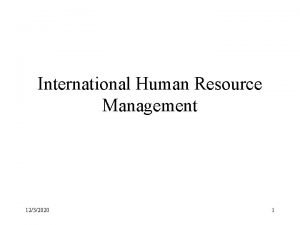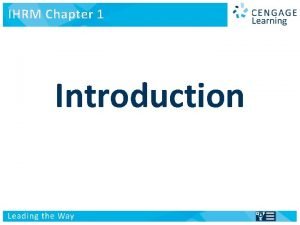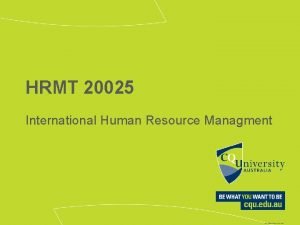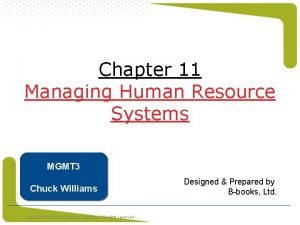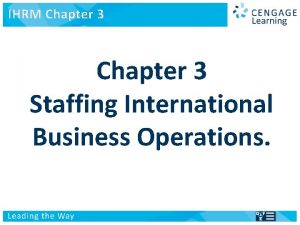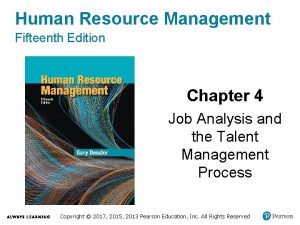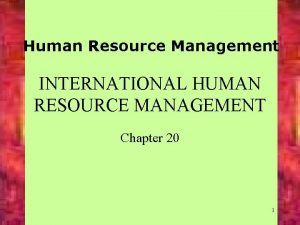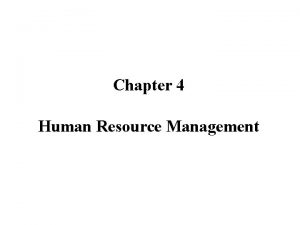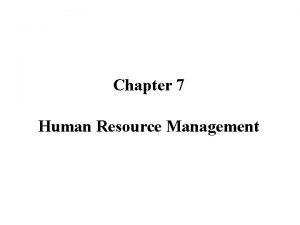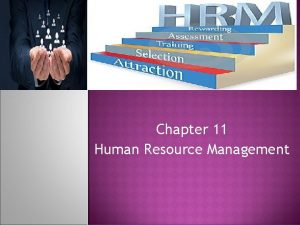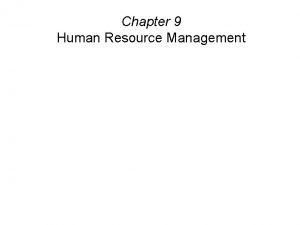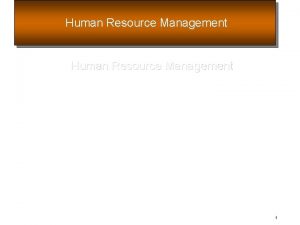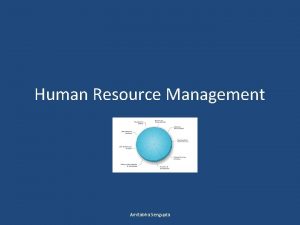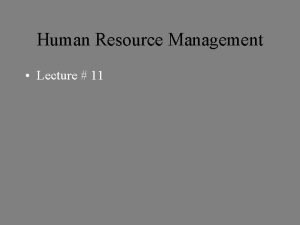CHAPTER 14 INTERNATIONAL HUMAN RESOURCE MANAGEMENT Power Point















- Slides: 15

CHAPTER 14 INTERNATIONAL HUMAN RESOURCE MANAGEMENT Power. Point Presentation by Charlie Cook Copyright © 2002 South-Western. All rights reserved

The International Imperative • Why organizations expand internationally: – To capture enhanced market opportunities that foreign countries may present. – To achieve economies of scale in production and administration by expanding the scope and volume of operations to international markets. – Keeping up with industry leaders may require that an organization enter foreign markets. – Acquiring ownership of a foreign-based organization or subsidiary. Copyright © 2002 South-Western. All rights reserved. 2

How International and Domestic HRM Differ • International HRM requires: – Managing a broader range of functional areas. – Becoming more involved in employees’ personal lives. – Setting up several different HRM systems for different geographic locations. – Dealing with more complex external constituencies – Participating in international assignments that have heightened exposure to personal risk. Copyright © 2002 South-Western. All rights reserved. 3

International Expansion • Strategies for expanding internationally: – Exporting locally produced goods to the host country. – Subcontracting or licensing the production of certain goods or services to a foreign partner. – Entering into a joint venture with a foreign partner. – Setting up operations (making a direct investment) in the form of a foreign branch or subsidiary. Copyright © 2002 South-Western. All rights reserved. 4

Assessing Culture: Hofstede’s Cultural Differences Dimensions • Individualism or collectivism – Individualistic societies value the development of and focus on the individual; collective societies value group relationships. • Power distance – The extent to which a society is hierarchical, and how power is distributed among its members. • Uncertainty avoidance – The extent to which a society feels comfortable with ambiguity and values and encourages risk-taking. • Quantity versus Quality of Life Copyright © 2002 South-Western. All rights reserved. 5

Assessing Culture Copyright © 2002 South-Western. All rights reserved. 6

Hall’s Model of Cultural Differences • Five silent languages that define patterns of communication in the culture: – Time- the importance or sense of time in daily activities. – Space (distance)- the amount of physical distance individuals attempt to maintain between themselves and others. – Material goods- the emphasis or inferences on the possession of goods to signify power, success and status – Friendships- the importance of friendships in conferring status on an individual. –©Agreementsconsiders how agreements are Copyright 2002 South-Western. All rights reserved. 7

Strategic HR Issues in International Assignments • Approaches to sending employees abroad: – Administrative approach involves merely assisting the employee destined for an international assignment with paperwork and minor logistics – Tactical approach involves managing the “risk or failure” factor of overseas assignment by providing paperwork assistance and a modest amount of training. – Strategic approach involves extensive support and coordination of the international assignment and a strategized repatriation program at the end of the assignment. Copyright © 2002 South-Western. All rights reserved. 8

Copyright © 2002 South-Western. All rights reserved.

Strategic HR Issues in International Assignments (cont’d) Copyright © 2002 South-Western. All rights reserved. 10

Determining Expatriate Compensation • Balance sheet method – Expatriate salary is based on home country pay and additional expenses associated with relocation and the assignment are accounted for, plus hardship and incentives to determine the overall reimbursement and compensation level. • Higher-of-home-or-host method – Employee’s salary at home is adjusted upward to account for a higher cost of living in the host country. • Localization approach – Employee’s salary is converted to the host country’s equivalent when the employee is on permanent Copyright © 2002 South-Western. All rights reserved. 11 assignment.

Setting Strategic HR Standards Copyright © 2002 South-Western. All rights reserved. 12

Repatriation Copyright © 2002 South-Western. All rights reserved. 13

Reading 14. 1: Managing a Global Workforce: Challenges and Strategies • Challenges: – Deployment in getting the right skills to the right place in the organization regardless of geographic location. – Knowledge and innovation dissemination and transfer where all business units concurrently receive and provide information. – Talent identification and development of those employees with the abilities and skills to function effectively in a global organization. Copyright © 2002 South-Western. All rights reserved. 14

Reading 14. 1: Managing a Global Workforce: Challenges and Strategies • Strategies for managing the global workforce: – Develop aspatial careers for employees that provide rich contextual knowledge of the environments and cultures in which organization operates. – Provide specific awareness building assignments that develop cross-sensitivity to cultural intricacies of a global enterprise in high potential employees in a short time. – Utilize SWAT teams of experts deployed on a shortterm basis to solve operational problems and complete technical projects. – Adopt virtual solutions to problems by using electronic communication technologies to connect 15 Copyright © 2002 South-Western. All rights reserved.
 What is human resources management
What is human resources management International human resource management dowling 6th edition
International human resource management dowling 6th edition Similarities between domestic and international hrm
Similarities between domestic and international hrm International resource services
International resource services Time management in human resource management
Time management in human resource management Hrm in retail management
Hrm in retail management Role of personnel management
Role of personnel management Hrm chapter 2
Hrm chapter 2 Chapter 9 human resources management
Chapter 9 human resources management Chapter 11 human resource management
Chapter 11 human resource management Human resource management chapter 1
Human resource management chapter 1 Intro to human resource management
Intro to human resource management Human resource management lecture chapter 1
Human resource management lecture chapter 1 Human resource management lecture chapter 1
Human resource management lecture chapter 1 Chapter 3 human resource management
Chapter 3 human resource management Chapter 4 job analysis and the talent management process
Chapter 4 job analysis and the talent management process
